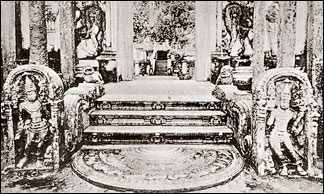The Naga motif in Sinhala sculpture
By Professor Abaya Ariyasinghe
The ancients in the Orient believe that mankind is beguiled,
surrounded, suppressed and comforted in their lives by the abundant
homely guardian-personalities. The function of such guardians is
dictated by the continuous efficacy of the cosmic power which governs
the world.
|

Naga figures are found on either side of the moonstones |
Genii (yakkhas) represents the forces of the soil and the mineral
treasures such as precious stones and jewels. Serpent kings (nagas)
direct the territorial waters of lakes, ponds, rivers and seas.
Tree-goddesses (Vrkshadevatas) patronise the kingdom of vegetation.
Sacred elephants symbolically consorted with the clouds.
These elephants bestow upon the human world all the boons of earthly
happiness such as abundance of crops, herds of cattle, prosperity,
offsprings, health and long life.
Vedic gods such as Vishnu and Balarama also known as Baladeva are
closely associated with the Nagas. God Vishnu rests on the coil-bed of
Ananta, king of the Nagas. God Balarama, brother of Krisna had the
experiences of emitting a naga out of his mouth while resting on the -
beach.
The Buddha spent the sixth week following the Enlightenment under the
coil of a Naga king called Mucalinda. In India and Sri Lanka there are a
number of examples of Naga figures in sculpture.
Among the ancient ruins in the island one may notice three groups of
Naga figures carved on stone. Most of them, are in the anthromophic
form. As found on the guard stone placed before the entrance of
religious buildings.
Figures in natural forms are few. A five headed Naga figure seen on
the cave canopy of the Nagapokuna is an excellent example. Naga figures
may be studied under several groups according to the number of hoods
they bear.
Naga figures with seven figures are common among ancient ruins. They
are carved either on guard stones or on the surface of other stones.
There are a few Naga stones with five hoods.Most of them are found on
the banks of lakes and ponds. They are never found at or near religious
buildings.
According to the norm of Hindu literature such figures represents the
god Baladeva, the guardian of the waters. The Nagapokuna referred above
shows a Naga with five hoods. On the bank of the Kuttampokuna at
Anuradhapura are found four naga figures at the four corners of its
bank. These five-headed Naga figures undoubtedly represent god Balarama.
There is another group of Naga figures with seven hoods. Most of them
are found carved in bas-relief in guard stones placed on either side of
the moonstones found at the entrance of religious buildings.
Though there are a number of attempts to attribute a meaning to this
motif, Prof. S. Paranavitana’s identification seems to be convincing.
According to him it suggests the divine Naga called Ananta, depicting
Time which element is the destructor of all worldly things.
According to the location of the Naga figures the meaning may vary in
literature, the Buddha is some times described as the Buddha Naga. The
term Naga here means noble or sublime. In some cases the seven hooded
Naga could be interpreted as an attempt to represent the Buddha.
There is a figure of an elephant in the Kalsi inscription of king
Asoka. This figure carries a short line of a short inscription saying
GAJATAMA, indirectly suggesting the Buddha.
Nine hooded Naga figures are very few. An excellent Naga figure of
that description is found at Seruvila. It is commonly called the
Mucalinda Naga. Under its hoods sits the Buddha in meditation. This
reminds us the seventh week of the Buddha spent on the bank of the
Mucalinda lake.
In Indian art, the anthromophic figure of a Naga within a shield of
many hoods is available. This slab has been discovered in the premises
of the ancient Nalanda University.
The mark of a male naga and a female naga (nagini) is suggested by
the number of hoods they show. The female nagini is always shown with a
single hood. A fine example is found in a slab in the compound of the
Medirigiriya Vatadage compound. Another example is found at the Tabbova
tank.
The nagini figure here is one member of a family of Nagas depicted
there. This guard stone at Tabbova is hailed as a unique one in this
branch of study. |
